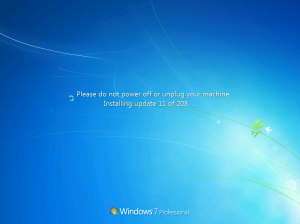Bereits im Mai hatte es Microsoft angekündigt, nun ändert man auch für Windows 7 und Windows 8.1 seine Update Strategie und führt auch hier ähnlich wie für Windows 10 monatliche kumulative Updates ein. Ab Oktober wird es also keine einzelnen Updates mehr geben, sondern nur noch ein Sammelupdate.
Das Ganze hat natürlich Vor- und Nachteile. War es bisher so, dass man nach der Neuinstallation von Windows 7 mehrere hundert einzelne Updates herunterladen und installieren musste, so genügt zukünftig einfach das jeweils aktuellste Update.

Das Rollup vom November 2016 wird also alle Updates vom November enthalten, aber natürlich auch die Updates des Vormonats. Gleichzeitig wird es aber auch so sein, dass Rechner, welche bereits ein Rollup Package installiert haben, in den darauffolgenden Monaten ein Express-Paket laden werden, um die Downloadgröße zu reduzieren. Es ist also anzunehmen, dass bereits installierte Updates in dem neuen Rollup nicht mehr enthalten sind. Wie dies im Detail technisch gelöst wird, darüber schweigt sich Microsoft noch aus.
Each month’s rollup will supersede the previous month’s rollup, so there will always be only one update required for your Windows PCs to get current. i.e. a Monthly Rollup in October 2016 will include all updates for October, while November 2016 will include October and November updates, and so on. Devices that have this rollup installed from Windows Update or WSUS will utilize express packages, keeping the monthly download size small.
Trotz allem sollen die Rollups natürlich kumulativ sein. Man braucht also nur das jeweils letzte Rollup Paket.
Over time, Windows will also proactively add patches to the Monthly Rollup that have been released in the past. Our goal is eventually to include all of the patches we have shipped in the past since the last baseline, so that the Monthly Rollup becomes fully cumulative and you need only to install the latest single rollup to be up to date.
Ein Nachteil der monatlichen Rollups ist natürlich ganz klar die Tatsache, dass man zukünftig nicht mehr auf einzelne Updates gezielt verzichten kann. Das kann natürlich zum einen dann ein Problem sein, wenn eine bestimmte Komponente ein Kompatibilitätsproblem mit einer installierten Anwendung verursacht. Oder wenn es andere Gründe gibt, aus denen man bisher bestimmte Updates ganz bewusst nicht installiert hat.
Allerdings gibt es wenigsten ein weiteres Update Paket, welches nur die sicherheitsrelevanten Updates des aktuellen Monats enthält, sowie ein Paket, welches nur .NET Updates enthält. Bestimmte Updates wie für den Servicing Stack oder Adobe Flash sind in den Rollups nicht enthalten und werden weiterhin separat zur Verfügung gestellt.
Also from October 2016 onwards, Windows will release a single Security-only update. This update collects all of the security patches for that month into a single update. Unlike the Monthly Rollup, the Security-only update will only include new security patches that are released for that month. Individual patches will no longer be available. The Security-only update will be available to download and deploy from WSUS, SCCM, and the Microsoft Update Catalog. Windows Update will publish only the Monthly Rollup – the Security-only update will not be published to Windows Update. The security-only update will allow enterprises to download as small of an update as possible while still maintaining more secure devices.
Als Kanäle für die Rollups nennt Microsoft Windows Update, WSUS, SCCM und den Microsoft Update Catalog, beim letztgenannten Katalog arbeitet man derzeit auch daran, jeden Browser zu unterstützen, also auch jene ohne ActiveX-Unterstützung (Chrome, Firefox, usw.).
Quelle: Microsoft Blog
Schreibe einen Kommentar